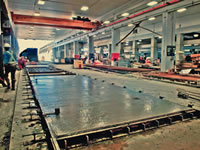 During an October 4 open house that drew 500 students, architects and engineers to its Edmonton precast plant, Lafarge Canada announced participation in a local Habitat for Humanity Net Zero energy duplex project. The producer continued to spotlight the project—the first of its kind in Canada—on October 6, when Lafarge opened its Calgary precast operation to about 700 community and construction industry guests. Both events were timed around the Canadian Precast/Prestressed Concrete Institute-designated National Precast Day, now in its 13th year and observed in plants across the provinces the first week of October.
During an October 4 open house that drew 500 students, architects and engineers to its Edmonton precast plant, Lafarge Canada announced participation in a local Habitat for Humanity Net Zero energy duplex project. The producer continued to spotlight the project—the first of its kind in Canada—on October 6, when Lafarge opened its Calgary precast operation to about 700 community and construction industry guests. Both events were timed around the Canadian Precast/Prestressed Concrete Institute-designated National Precast Day, now in its 13th year and observed in plants across the provinces the first week of October.
Scheduled to commence later this fall, the Habitat for Humanity Edmonton project is in partnership with Edmonton-based architect and consulting engineering giant Stantec, and will be a sustainable, Net Zero energy home constructed almost entirely of high performance precast concrete. The two-story, 1,560-sq.-ft. duplex’s innovative design, coupled with sustainable materials, will help create what the sponsors see as the ultimate energy-efficient precast concrete home.
Precast products used to make the duplex will include insulated precast concrete sandwich panels (R-44) for basement and exterior walls; 6-in.-thick precast demising shear wall between the suites; 10-in. prestressed hollowcore floor and roof slabs; precast steps, stairs and landings; precast balcony; and two precast “living wall” planters. All totaled, the frame of the structure will be constructed from more than 80 precast concrete pieces assembled on site. All of the home’s aggregates, cement and gypsum wallboard will be supplied by Lafarge.
Using an existing habitat site as a theoretical test fit, the Habitat Net Zero Prototype was developed to respect existing site constraints, typical habitat floor plans, and city development regulations. Precast concrete panels also had to be developed in a manner that they could be easily fabricated and altered within Lafarge’s standard form liners and pouring beds. Once these structural and dimensional limitations were understood, the moulding and manipulation of existing plans could take shape.
While the footprint and orientation of the units were to remain fixed, due to existing permitting, the units were manipulated slightly to provide private covered entrances, as well as second floor projections, which eroded away at the original symmetrical façade. Each unit was now treated as an individual piece forming a whole and allowed each to form their own identity responding to site, solar, and abutting landscape conditions.
The building will draw heat from beneath the ground via geothermal energy storage. Passive solar heating cells on the roof will supply power. Lafarge said the building will give back to the energy grid in summer what it consumes in winter. As a result, the Habitat for Humanity families chosen for the pilot project home won’t have to pay for utilities.
“Lafarge is proud to support Habitat in this pilot that will show how precast concrete can be used to build highly energy efficient homes while helping members of our community,” says Lafarge’s Rene Thibault, Western Canada Aggregates & Concrete regional president. “National Precast Day is an opportunity to educate engineers, architects and students about sustainable construction and the ideal occasion to feature a NetZero energy home.”
“As a longtime supporter of Habitat, Stantec provided the architectural design and sustainability consulting for [an] innovative project that offers exemplary environmental performance,” adds Stantec Edmonton Region Vice President Keith Shillington. “This results in lower monthly utility costs that make this home attainable for more hard-working families in Edmonton, while the lessons learned here can be replicated worldwide.”
Modular building segments see strong gains
U.S. nonresidential prefabricated building system demand is expected to exceed $15 billion in 2015, an increase of 7.8 percent annually, according to the new study, Nonresidential Prefabricated Building, from The Freedonia Group, a Cleveland-based research firm. This is a strong showing compared to the weakness over much of the previous decade. The increased demand is due to recovery in office and commercial construction, coupled with continued gains in institutional, industrial and agricultural construction. The development of new products and technologies, including more tailored designs and improved concrete mixes, are also providing opportunities. However, competition from traditional site building will remain intense, and moderating prices for many of the raw materials used in prefabricated building systems will restrain value growth.
The study also predicts that among nonmetal building systems, the modular building segment is expected to see the strongest gains, just ahead of the panelized precast concrete segment. According to the report, modular building will benefit from robust growth in both commercial and institutional construction activity, as well as from the growing popularity of prefabricated bathroom and kitchen modules. Gains for panelized precast systems will be driven by increases in office and commercial construction, among the more popular applications for these systems. In addition, technological improvements, including better reinforcement materials, improved concrete mixtures and greater design options, will support demand.
The 285-page Nonresidential Prefabricated Building Systems is available for $4,800 from The Freedonia Group and can be purchased at www.freedoniagroup.com.




